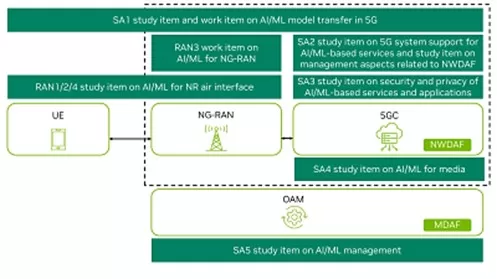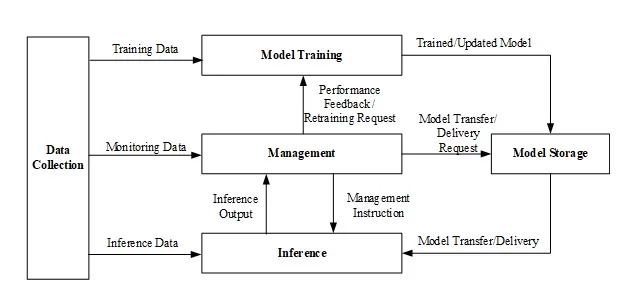Introduction
The landscape of mobile communications has been witnessing a rapid and transformative evolution, especially with the advent of the fifth generation (5G) technologies. The 3rd Generation Partnership Project (3GPP), a crucial body in the mobile communications industry, has been at the forefront of this evolution, introducing pivotal enhancements in its successive releases. Each release by 3GPP not only brings forward technological advancements but also sets new standards for network efficiency, performance, and capabilities.
Release 16 laid down a solid foundation, introducing numerous enhancements and laying the groundwork for more advanced applications of 5G. It was a step towards realizing the full potential of 5G, with a focus on enabling new use cases and improving network performance.
As we progressed to Release 17, a notable shift was observed towards more efficient utilization of the spectrum. Dynamic Spectrum Sharing (DSS) emerged as a key feature, allowing operators to maximize their existing spectral resources by seamlessly sharing them between 4G LTE and 5G NR technologies. This enhancement was pivotal in driving the widespread adoption and deployment of 5G networks without necessitating the complete overhaul of existing infrastructures.
Now, as we anticipate the arrival of Release 18, a groundbreaking shift is expected with the integration of Artificial Intelligence (AI) and Machine Learning (ML) into the fabric of 5G networks. The potential of AI/ML in revolutionizing the way networks adapt to changing conditions and user demands is immense, suggesting a future where networks are not just faster and more reliable, but also smarter and more responsive.
In this article, we explore how dynamic spectrum sharing has matured in Release 17 and analyze the pivotal role AI/ML is set to play in Release 18.
Dynamic Spectrum Sharing in Release 17
The introduction of Dynamic Spectrum Sharing (DSS) in 3GPP Release 17 marked a significant advancement in the efficient utilization of spectral resources for 5G networks. DSS emerged as a strategic solution to one of the primary challenges in the deployment of 5G: the scarcity and cost of spectrum.
The Essence of DSS in 5G Networks
DSS technology enables mobile operators to use a single spectrum band simultaneously for both 4G LTE and 5G New Radio (NR) transmissions. This functionality is crucial, particularly for operators with limited spectrum resources, as it allows them to dynamically allocate spectrum based on real-time demand without the need for dedicated spectrum for each technology. This capability not only optimizes spectrum utilization but also facilitates a smoother and more cost-effective transition from 4G to 5G.
Operational Mechanism and Advantages
At its core, DSS operates by intelligently overlaying 5G NR signals on existing 4G LTE signals within the same frequency band. This overlay is managed dynamically, adjusting the allocation of spectrum between 4G and 5G based on user demand. One of the key advantages of DSS is its flexibility. It allows operators to ramp up 5G coverage and capacity without decommissioning their 4G services, ensuring continuous service provision across both network generations.
Implementation and Technical Aspects
Implementing DSS requires certain upgrades to the existing network infrastructure, including software updates to base stations and a need for devices that are compatible with both 4G and 5G technologies. The complexity of DSS lies in its need to manage interference and maintain efficient signaling between the overlaid technologies. This requires sophisticated algorithms to ensure seamless coexistence and optimal performance of both 4G and 5G services within the shared spectrum.
Impact on Network Performance
The deployment of DSS in Release 17 has shown promising results in enhancing network performance. By leveraging existing infrastructure and spectrum, operators have been able to rapidly expand their 5G footprint while maintaining robust 4G services. Furthermore, DSS facilitates better management of network resources, adapting to varying traffic patterns and demands, thereby improving overall network efficiency and user experience.
In conclusion, DSS in Release 17 represents a strategic leap in spectrum management for 5G networks, offering a pragmatic and efficient path for operators to maximize their existing spectral assets while paving the way for widespread 5G deployment.
AI and ML in Release 18
The 3GPP Release 18 is poised to bring about a transformative change in the world of 5G technology with the integration of Artificial Intelligence (AI) and Machine Learning (ML). This shift marks the beginning of an era where intelligent, data-driven decisions redefine network operations and performance.
The systematic integration of AI/ML spans across the entire 5G ecosystem, right from the user equipment (UE) to NG-RAN, all orchestrated under the watchful eye of network management entities.
The following figure illustrates the collaborative landscape of AI/ML integration within the 5G architecture, as per 3GPP Release 18, showcasing the pivotal roles of different study items and work groups. This integration promises to usher in a new era of network intelligence, efficiency, and user-centric services.

Figure 1: Overview of AI in 5G-Advanced in 3GPP Release 18
Revolutionizing Network Management with AI/ML
In Release 18, AI and ML are set to overhaul traditional network management approaches. These technologies promise to bring about a new level of efficiency and automation in network operations. By analyzing vast amounts of network data, AI-driven systems can predict network demands, optimize resource allocation, and even preemptively address potential issues before they impact users.
Enhancing Physical Layer Performance
One of the critical areas where AI/ML will have a significant impact in Release 18 is the physical layer of the 5G network. Through advanced algorithms, AI/ML can optimize signal processing, modulation, and coding schemes, leading to improved spectral efficiency, higher data rates, and more reliable connections. This optimization is particularly crucial for supporting the ever-increasing demand for bandwidth and low-latency applications.
AI in Network Slicing and Load Balancing
Network slicing, a key feature of 5G, stands to gain immensely from the integration of AI/ML. AI algorithms can dynamically manage and optimize network slices, ensuring that each slice meets its specific service level agreements (SLAs). Similarly, AI-driven load balancing can intelligently distribute network traffic, enhancing the overall user experience and network efficiency.
AI-Enabled RAN Intelligence in 3GPP Release 18
The primary objective of AI-enabled RAN intelligence in Release 18 is to enhance network efficiency and user experience through predictive and adaptive network management. Key focus areas include:
- Network Energy Saving: Implementing AI algorithms to optimize energy use across the RAN, thereby contributing to more sustainable and cost-effective network operations.
- Load Balancing: Utilizing AI to dynamically distribute network traffic and resources, ensuring optimal performance even during peak demand periods or in densely populated areas.
- Mobility Optimization: Enhancing the handover process and overall mobility management by predicting user movement and adjusting network parameters proactively for seamless connectivity.
AI/ML for Enhanced PHY Performance
Incorporating AI/ML into the 5G PHY layer, as specified in the 3GPP Release 18 document 38.843 “Study on Artificial Intelligence (AI)/Machine Learning (ML) for NR air interface”, marks a transformative step in the evolution of wireless communication technologies.
In this new paradigm, the PHY layer is envisioned as an intelligent system capable of self-optimization through several interconnected functions. Data collection serves as the foundation, gathering the necessary input for the AI/ML models to learn, adapt, and make decisions. This encompasses not only the training data needed to develop and refine these models but also the monitoring data that guides their management and the inference data that helps draw actionable insights.
The model training function lies at the heart of this framework, tasked with the iterative process of training AI/ML models and validating their performance against key metrics. This function ensures that models are prepared to handle the demands of a dynamic network environment.

Figure 2: Functional framework for AI/ML for NR Air Interface
Management functions play a pivotal role, orchestrating the operation and monitoring of AI/ML models. These functions make crucial decisions on model deployment, ensuring the network’s proper response to varying conditions.
The inference function applies the insights gained from AI/ML models to the real-time data streaming through the network. This application produces outputs that inform network adjustments and optimizations, making it a key driver of network responsiveness.
Model storage is a crucial aspect of the framework, maintaining a repository of AI/ML models that the network can access and deploy as needed. This function enables the network to utilize the best-suited models for given situations, facilitating efficient operation.
This AI/ML integration promises several improvements, including enhanced spectrum utilization that allows the network to allocate resources more efficiently, reducing interference, and boosting throughput. Intelligent beam management adapts to user movements and channel variations for consistent signal quality. Furthermore, dynamic configuration of MIMO systems optimizes spatial resource utilization, increasing network capacity.
However, this advancement doesn’t come without challenges. The computational demands for real-time AI/ML processing necessitate powerful computational resources. The models must operate within the stringent low-latency requirements of 5G services. Continuous monitoring and updating of AI/ML models are paramount to maintaining performance standards.
In summary, the 3GPP Release 18 framework for AI/ML in the NR air interface sets forth a vision for a more intelligent and adaptive 5G PHY layer. By confronting the technical challenges and harnessing the power of AI/ML, the 5G network is on the cusp of significant enhancements in efficiency, capacity, and user experience.
Challenges in AI/ML Deployment in 5G Networks
Looking ahead, AI/ML’s role is expected to evolve continuously. Future developments may include more sophisticated algorithms capable of handling even more complex network environments and user scenarios.
The deployment of AI and Machine Learning in 5G networks, particularly as envisaged in 3GPP Release 18, introduces a range of challenges that must be addressed to fully realize the potential of these advanced technologies.
Computational Demands and Resource Allocation
One of the most significant challenges is the high computational demand of AI/ML algorithms. The processing power required for real-time data analysis and decision-making can strain existing network infrastructure. Efficient resource allocation, including the deployment of edge computing capabilities, is crucial to manage this computational load.
Data Privacy and Security Concerns
The integration of AI/ML involves handling large volumes of sensitive user data. Ensuring data privacy and securing the network against potential breaches are paramount. This involves implementing robust encryption techniques, secure data storage, and advanced cybersecurity protocols.
Algorithm Complexity and Optimization
AI/ML algorithms can be highly complex, necessitating specialized expertise for development and optimization. The challenge lies in designing algorithms that are not only accurate but also efficient in terms of power and resource usage, especially for edge-based deployments.
Network Integration and Interoperability
Integrating AI/ML into existing 5G network architectures presents several technical hurdles. Ensuring compatibility and interoperability between different network components, legacy systems, and various AI/ML models is a complex task that requires careful planning and execution.
Training and Deployment of AI Models
Training AI/ML models requires vast amounts of high-quality data. Collecting, processing, and utilizing this data effectively, while maintaining system performance and user experience, is a significant challenge. Furthermore, deploying these models across diverse network environments must be managed carefully to avoid disruptions in service.
Regulatory Compliance and Ethical Considerations
Adhering to regulatory standards and addressing ethical considerations, especially concerning data usage and AI decision-making processes, is imperative. Navigating the complex landscape of global regulations and ensuring ethical AI practices is a challenge that extends beyond technical realms.
In conclusion, while AI/ML deployment in 5G networks offers transformative potential, overcoming these challenges is crucial for successful implementation. It requires a multi-faceted approach involving technical innovation, strategic planning, and regulatory compliance to harness the full power of AI/ML in enhancing 5G network capabilities.
Conclusion
As we reflect on the journey from 3GPP Release 16 through to Release 18, it’s evident that the landscape of mobile communications is undergoing a significant transformation.
Now, with the anticipated Release 18, we stand on the brink of a new era in which AI and Machine Learning are set to redefine the capabilities of 5G networks. This integration is poised to revolutionize network operations, making them not just faster and more reliable but also significantly smarter and more responsive to the intricacies of user demand and environmental conditions.
From enhancing the physical layer’s performance to optimizing network slicing and load balancing, AI/ML is the cornerstone of a more efficient, automated, and user-centric network infrastructure.
The collaborative landscape of AI/ML within the 5G architecture, as showcased in Release 18, promises a network that not only adapts but also predicts and evolves in real-time. This is a network that can manage its resources proactively, delivering an enhanced user experience while driving down operational costs and improving sustainability.
As we look to the future, the continuous evolution of AI/ML will bring about even more sophisticated algorithms capable of navigating complex network environments and user scenarios. Yet, this path is not without its challenges. The computational demands, privacy and security concerns, and the need for seamless integration within existing networks pose considerable hurdles that must be addressed.
In conclusion, the technical evolution from 3GPP Release 16 to Release 18 marks a pivotal shift towards a more intelligent and adaptive 5G ecosystem. With the right strategies to overcome implementation challenges, the integration of DSS and AI/ML holds the promise of not just meeting but exceeding the lofty expectations placed on the next generation of mobile communications.
References
- Lin, “Artificial Intelligence in 3GPP 5G-Advanced: A Survey”, IEEE Communications Society, 2023.
- Lin et al., “5G new radio: Unveiling the essentials of the next generation wireless access technology,” IEEE Communications Standards Magazine, vol. 3, no. 3, pp. 30-37, September 2019.
- 3GPP TS 38.843, “Study on Artificial Intelligence (AI)/Machine Learning (ML) for NR air interface”, Release 18, 2023.
- 3GPP TS 23.288, “Architecture enhancements for 5G system (5GS) to support network data analytics services,” V17.9.0, 2023.

